Dive Physiology - PowerPoint PPT Presentation
1 / 12
Title:
Dive Physiology
Description:
Mediastinal Emphysema. Subcutaneous Emphysema. Pressure ... Mediastinal Emphysema. Pneumothorax. Air Embolism - Decompression Sickness (The Bends) (DCS) ... – PowerPoint PPT presentation
Number of Views:1663
Avg rating:3.0/5.0
Title: Dive Physiology
1
- Dive Physiology
- And
- Medical Aspects
2
Underwater Physiology
- Respiration
- Effects of heat and cold
- Barotrauma
- Pressure related problems
- Direct
- Indirect
3
Respiration
- The breathing cycle
- Oxygen consumption
- Carbon dioxide
- Breath holding
- Hypoxia
- hypercapnia/hypocapnia
- Carbon monoxide poisoning
4
Respiration
Respiration
The Process
Movement of air into and out of the lungs
Transport of oxygen to the cells and removal of
carbon dioxide
Aorta
Pulmonary Artery
Mouth, Nose, Throat
Lungs
O2
CO2
Bronchioles
Trachea
O2
CO2
Pulmonary Vein
Bronchi
Capillaries
Alveoli
Heart
Lungs
Vena Cava
Diaphragm
Hemoglobin Molecules in Red Blood Cells Carry
Oxygen
Air Must Pass Through Dead Spaces
5
Effects of Heat and Cold
- Heat injuries (hyperthermia)
- cramps
- exhaustion
- stroke
- Cold injuries (hypothermia)
- Decreased body functions
- Decreased mental functions
- Shivering, numbness
- Related protection requirements
6
Temperature Injuries
Temperature Injuries
Progressive Symptoms and Effects
Heat Cold
- Cramps - Exhaustion - Stroke Profuse
Sweating Weakness Malaise Dry, Flushed
Skin Cool Victim Oral Fluids No
Caffeine/Alcohol
- Hypothermia Uncontrolled Shivering Loss of
Coord/Dexterity Numbness Warm Victim No
Caffeine No Alcohol
Symptoms
Symptoms
1st Aid
1st Aid
7
Pressure Related Problems(direct)
- Descent (squeezes)
- Ears
- Sinuses
- Mask
- Thoracic
- Teeth
- Stomach/Intestines
- Suit
- Ascent (expansion)
- Air embolism
- Pneumothorax
- Mediastinal Emphysema
- Subcutaneous Emphysema
8
(No Transcript)
9
Pressure Related Problems(indirect)
- Decompression sickness
- Nitrogen partial pressures
- Solubility
- Nitrogen narcosis
- Oxygen toxicity
10
Nitrogen narcosis
Nitrogen Narcosis Rapture of the Deep -
Martinis Law
SURFACE
Thinking and Judgment POTENTIALLY Affected
75-100
Symptoms and Effects on Individual Diver
Vary With Depth and Exposure.
Communication, Motor and Mental Tasks IMPAIRED
150-175
200
NOT IN CONTROL
11
Barotrauma
Direct Pressure Related Problems
Indirect Pressure Related Problems
Descend and Ascend Slowly to Minimize Potential
Problems
- Descent (Compression) Squeezes Ear,
Sinus, Lung, Stomach, Intestinal, Tooth,
Equipment - Ascent (Expansion) Lung Ruptures
- Subcutaneous and Mediastinal Emphysema Pneumotho
rax Air Embolism
- Decompression Sickness (The Bends) (DCS) -
Nitrogen Narcosis - Oxygen Toxicity
Precautionary Decompression Stops (Safety Stops)
Help Reduce Bubble Formation and Incidence of DCS
NEVER HOLD YOUR BREATH ON SCUBA!
12
Physiology Summary
Physiology Summary
Respiration is Mechanical - Oxygen-Carbon
Dioxide Exchange - Slow Deep Breathing
Barotrauma - Pressure Injury - Direct
Subcutaneous Emphysema Mediastinal Emphysema
Pneumothorax Air Embolism - Indirect DCS
(the Bends) Nitrogen Narcosis Oxygen Toxicity
Proper Exposure Protection is Required to Avoid
Hypothermia































